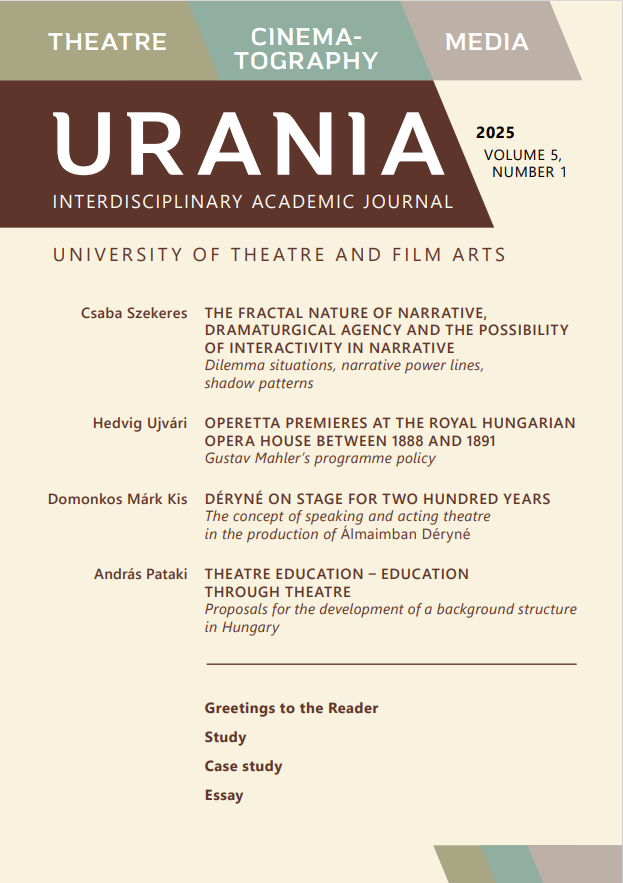The fractal nature of narrative, dramaturgical agency and the possibility of interactivity in narrative
Abstract
This study is part of a larger study in progress, which attempts to describe the interactivity inherent in film narrative and the sequentialisations that characterize narrative. My aim is to explore the basic features of the functioning of the film receptive attitude inherent in interactivity. The exploratory method builds on the claim that in the macro and micro structures of narrative the fractal nature of narrative, which carries the potential for interactivity, prevails through two dilemmas. Thus, not only the narrative power lines in the body of the text, which form the basic structure of the dramatic structure, but also its variants, the shadow patterns, become visible. Consequently, the dilemma situations are able to form narrative shadow patterns, inducing a decision agency, which reveal a dramaturgically structurable system of a character’s decision situations, thereby creating the possibility of dramaturgical agency. The starting point for the investigation of dramaturgical agency is the Interactive Digital Narrative (IDN), which is well known in video games. Its functioning is significantly influenced by the interpretation of chance, which creates coherent or incoherent decision patterns in the narrative structure with a paragraphic nature. The study indirectly tries to show, through the concept of chance, that its interpretative significance has a stimulating or enervating impact on the recipient during the reception process.
References
Aarseth, Espen J. 1997. Cybertext: Perspectives on Ergodic Literature. Baltimore: Johns Hopkins University Press.
https://doi.org/10.56021/9780801855788
Alloy, Lauren B. and Lyn Y. Abramson. 1997. “Illusion of Control: The Role of Personal Involvement.” Journal of Personality and Social Psychology 37, no. 7: 1217–1224. https://doi.org/10.1027/1618-3169/a000225
Arisztotelész. 1963. Poétika, Hungarian translation by János Sarkady. Budapest: Magyar Helikon Könyvkiadó.
Arisztotelész. 1997. Poétika, Hungarian translation by Zsigmond Ritoók. Budapest: PannonKlett.
Bandura, Albert. 1977. “Self-Efficacy: Toward a Unifying Theory of Behavioral Change.” Psychological Review 84, no. 2: 191–215.
https://doi.org/10.1037/0033-295X.84.2.191
Barron, Frank. 1953. “An Ego-Strength Scale Which Predicts Response to Psychotherapy.” Journal of Consulting Psychology 17, no. 5: 327–333.
https://doi.org/10.1037/h0061962
Bódizs, Róbert. 2005. “Álomképek és agyműködés: percepció vagy koncepció.” Pro Philosophia Füzetek 42: 73–85.
Bordwell, David. 1985. Narration in the Fiction Film. Madison, WI: University of Wisconsin Press.
Chaminade, Thierry and Jean Decety. 2002. “Leader or Follower? Involvement of the Inferior Parietal Lobule in Agency.” NeuroReport: For Rapid Communication of Neuroscience Research 13, no. 15: 1975–1978.
https://doi.org/10.1097/00001756-200210280-00029
Chatman, Seymour. 1978. Story and Discourse: Narrative Structure in Fiction and Film. Ithaca, NY: Cornell University Press.
Deleuze, Gilles and Felix Guattari. A Thousand Plateaus: Capitalism and Schizophrenia. Minneapolis, MN: University of Minnesota Press, 1987.
Dewey, John. 1916. Democracy and Education: An Introduction to the Philosophy of Education. New York: Macmillan.
Freud, Sigmund. 1900. Die Traumdeutung. Leipzig: Franz Deuticke.
Freud, Sigmund. 2011. A Farkasember: Sigmund Freud írásai, Hungarian translation by István Bart, Gábor Berényi and Katalin Schultz. Budapest: Animula.
Gaines, Elliot. 2010. Media Literacy and Semiotics. New York: Palgrave Macmillan.
https://doi.org/10.1007/978-0-230-11723-5
Genette, Gérard. 2006. Metalepszis, Hungarian translation by Zoltán Z. Varga. Bratislava: Kalligram.
Halverson, Jeffrey R., H. L. Goodall Jr. and Steven R. Corman. 2011. Master Narratives of Islamist Extremism. New York: Palgrave Macmillan.
https://doi.org/10.1007/978-0-230-11723-5.
Hartmann, Nicolai. 2013. Etika, Hungarian translation by Ferenc Simon. Budapest: Noran Libro Kiadó, 2013.
Heidegger, Martin. 1927. Sein und Zeit. Tübingen: Max Niemeyer Verlag.
Heller, Ágnes. 1970. A mindennapi élet. Budapest: Akadémiai Kiadó.
Herman, David. 2009. Basic Elements of Narrative. Malden, MA: Wiley-Blackwell.
https://doi.org/10.1002/9781444305920
Jenkins, Henry. 2006. Convergence Culture: Where Old and New Media Collide. New York: NYU Press.
Kierkegaard, Søren. 1843. Frygt og Bæven. Copenhagen: Reitzel.
“Kinoautomat na EXPO 1967”, YouTube video, 6:17. Posted by Czechoslovakia In Socialism, January 27, 2019. Online access: https://www.youtube.com/watch?v=nh5_Qi8zl0U (last visited: October 22, 2024).
Koenitz, Hartmut. 2015. “Towards a Specific Theory of Interactive Digital Narrative.” In Interactive Digital Narrative: History, Theory, Practice, 91–105. New York: Routledge. https://doi.org/10.4324/9781315769189-8
Koenitz, Hartmut. 2023. Understanding Interactive Digital Narrative: Immersive Expressions for a Complex Time. Abingdon, United Kingdom – New York: Oxon–Routledge.
https://doi.org/10.4324/9781003106425
Koenitz, Hartmut, Jonathan Barbara and Mirjam Palosaari Eladhari. 2023. “Interactive Digital Narrative (IDN)—New Ways to Represent Complexity and Facilitate Digitally Empowered Citizens.” Digital Creativity. Online access: https://www.tandfonline.com/doi/epdf/10.1080/13614568.2023.2181503 (last visited: June 1, 2024).
Lazarus, Richard S. and Susan Folkman. 1984. Stress, Appraisal, and Coping. New York: Springer.
Murray, Janet H. 2017. Hamlet on the Holodeck: The Future of Narrative in Cyberspace. Updated edition. Cambridge, MA: The MIT Press.
Penzer, N. M. and Charles Henry Tawney. 2020. The Ocean of Story, Being C. H. Tawney’s Translation of Somadeva’s Katha Sarit Sagara (or Ocean of Streams of Story). Volume VII. S. l.: Alpha Edition, 2020.
Roth, Christian and Hartmut Koenitz. 2019. “Bandersnatch, Yea or Nay? Reception and User Experience of an Interactive Digital Narrative Video.” In Proceedings of the 2019 ACM International Conference on Interactive Experiences for TV and Online Video, August 2019, 247–254.
https://doi.org/10.1145/3317697.3325124
Rotter, Julian B. 1954. Social learning and clinical psychology. New York, Prentice-Hall.
https://doi.org/10.1037/10788-000
Rotter, Julian B. 1966. “Generalized Expectancies for Internal Versus External Control of Reinforcement.” Psychological Monographs: General and Applied 80, no. 1: 1–28. https://doi.org/10.1037/h0092976
Rotter, Julian B. 1982. The development and applications of social learning theory: Selected papers. New York: Praeger.
Ursu, Marian F., Ian C. Kegel, Doug Williams, Maureen Thomas, Harald Mayer, Vilmos Zsombori, Mika L. Tuomola, Henrik Larsson, and John Wyver. 2008. “ShapeShifting TV: Interactive Screen Media Narratives.” Multimedia Systems 14, no. 2: 115–132. https://doi.org/10.1007/s00530-008-0119-z
Yamaguchi, Ikushi. 2003. „The Relationships Among Individual Differences, Needs and Equity Sensitivity.” Journal of Managerial Psychology 18, no. 4: 341–356. https://doi.org/10.1108/02683940310473082
Yorke, John. 2014. Into the Woods: A Five-Act Journey Into Story. New York: Harry N. Abrams, Inc.




